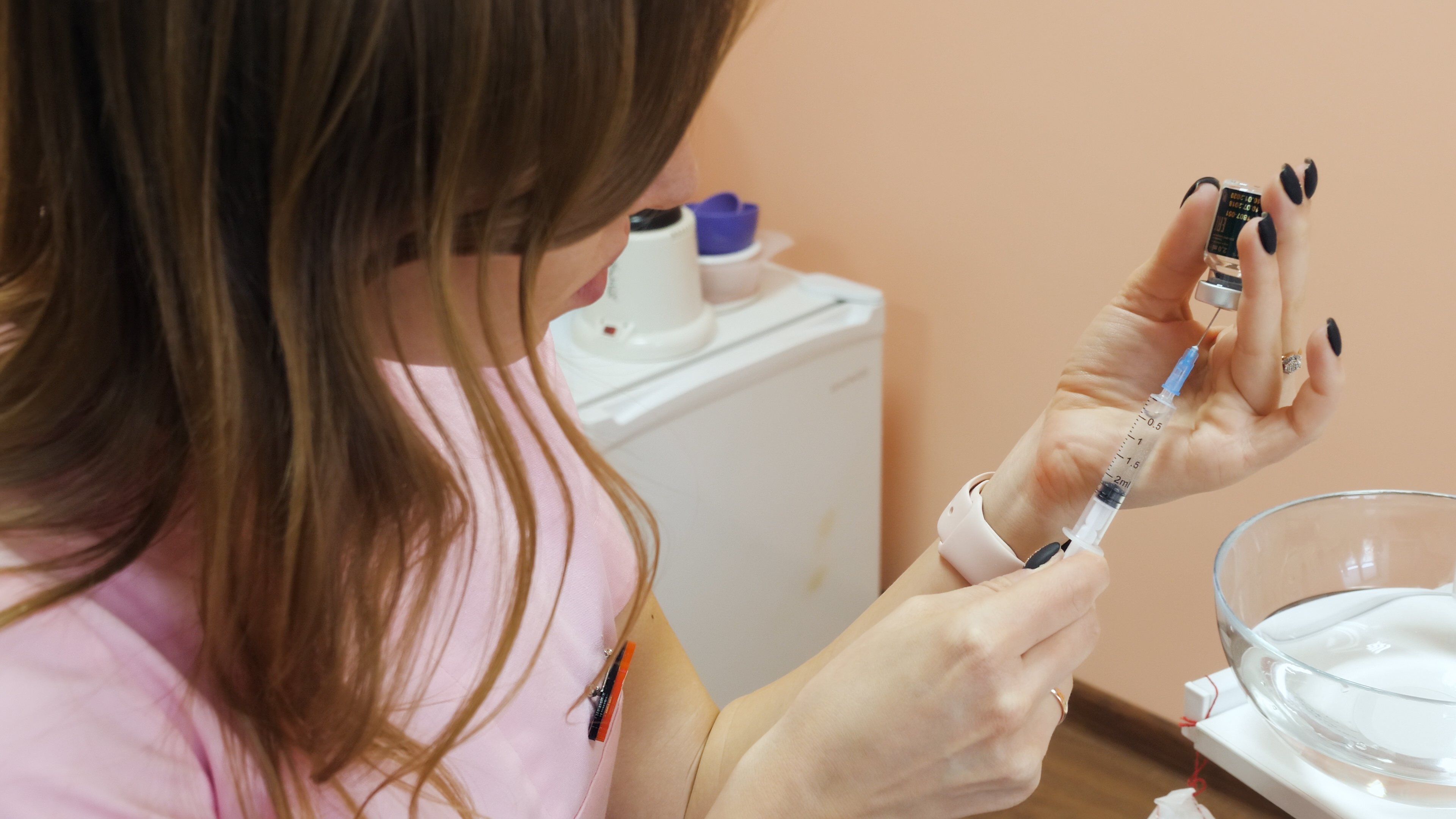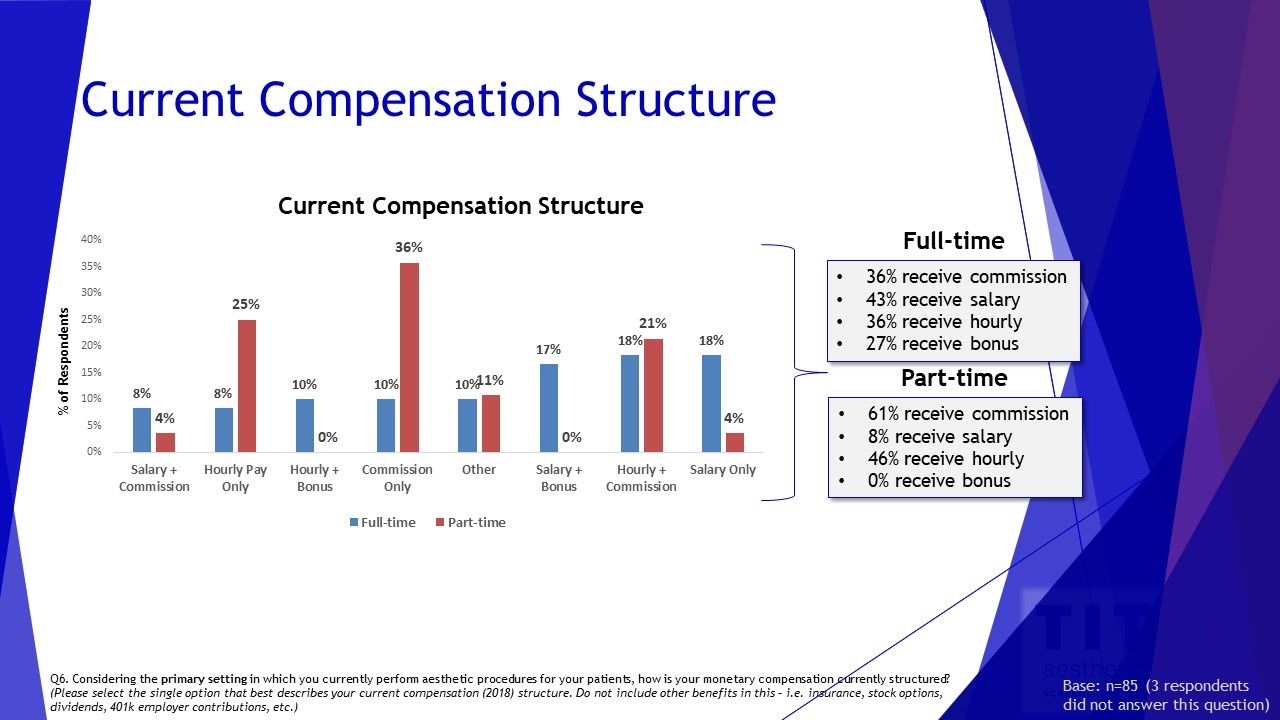- Case-Based Roundtable
- General Dermatology
- Eczema
- Chronic Hand Eczema
- Alopecia
- Aesthetics
- Vitiligo
- COVID-19
- Actinic Keratosis
- Precision Medicine and Biologics
- Rare Disease
- Wound Care
- Rosacea
- Psoriasis
- Psoriatic Arthritis
- Atopic Dermatitis
- Melasma
- NP and PA
- Skin Cancer
- Hidradenitis Suppurativa
- Drug Watch
- Pigmentary Disorders
- Acne
- Pediatric Dermatology
- Practice Management
- Prurigo Nodularis
- Buy-and-Bill
Publication
Article
Dermatology Times
The complexities of nonphysician compensation
Author(s):
Survey strives to provide a framework for fairly compensating nonphysician aesthetic providers.
Survey strives to provide a framework for fairly compensating nonphysician aesthetic providers. (Azhorov - stock.adobe.com)

Mary Beth Hagen

Table courtesy Mary Beth Hagen, CEO, Titan Aesthetic Recruiting

Perhaps the most important finding from the first-ever survey of nonphysician aesthetic provider compensation is that almost no two physician extenders are paid in the same way.
Top-line results showed that on average, full-time nonphysician aesthetic providers earn $158,670. However, looking at numbers alone greatly understates the complexity of nonphysician compensation, says Mary Beth Hagen, CEO/founder of Titan Aesthetic Recruiting, which sponsored the survey.
"It's fascinating -you can't say, 'this is how an injector gets paid' because every single respondent gave us a different answer." With variables including salary, hourly pay, commissions, bonuses and benefits in play, she says, virtually every respondent's pay scheme is unique.
Distributed through social media and e-mail, the survey targeted nurse practitioners (NPs), registered nurses (RNs) and physician assistants (PAs) in the United States whose practice consisted of at least 50% aesthetic procedures (mainly neuromodulators and dermal fillers).
Although 187 potential respondents clicked into the survey, she says, only 88 (47%) completed it. "I was surprised at the low completion rate." Several providers told Ms. Hagen off-line they didn't know enough about how they got paid to even answer the questions.
RNs (51% of the sample) earned an average of $129,000 annually, versus $189,000 for PAs (30%) and $196,000 for NPs (19%). Years of service at the same practice strongly impacted earnings. "We found that if you'd only been with your employer for one to two years, average earnings are about $138,000 (n = 13). But that definitely increased when you'd been at the employer for three to five years ($195,939; n = 16)." Years of injecting experience factored into compensation as well, with average compensation of $96,000 for an injector with only one to two years' experience (n = 6).
Poll: Do you employ a nonphysician injector in your practice?
By practice specialty, nonphysicians who worked for plastic or facial plastic surgeons earned the most: $170,000 annually. "What you're seeing there is that a lot of overhead is paid for by their surgical practice." These specialists also tended to employ much more tenured injectors, adds Ms. Hagen. This situation evolved, she says, largely because when the injectable market began exploding, surgeons typically delegated these duties to nonphysician staff wherever allowed by law. Full-time injectors who worked for dermatologists (who made up only 8% of the sample) or other specialists made approximately $142,000 yearly.
Geographically, the Southeast set the pace, with average annual earnings of $199,000. The fact that one-third of respondents practice in Florida, where RNs are not allowed to inject, may have skewed responses.
"We also found that if you were a full-time employee, you were much more likely to get additional benefits - such as life insurance, medical benefits, profit-sharing plans and 401(k)s." The most common type of benefit extended to part-time employees involved continuing medical education (CME) or personal-development training.
Additionally, the survey asked injectors who expected to work at the same practice next year what wage changes they expected. "We saw that 52% expect their compensation to increase this year, by about $33,000."
For participants considering switching employers, the top three concerns included work-life balance, commission or bonus structure and support for CME. The vast majority of respondents who reported leaving a practice due to inadequate compensation wanted fairly substantial increases -16% to 20% - Ms. Hagen says. When asked what nonphysician injectors should be paid, the average response was $134,069.
Regarding payment structures, 67% of respondents reported that commission or bonus potential is the most important component. "When you look at what people really value in a commission structure, most of them, as they're getting into their practice, value a commission or bonus structure more than a higher salary or hourly rate." The remaining 33%, who prioritized base salary, were primarily first- or second-year injectors.
Approximately half of respondents worked in physician-owned practices. "I was surprised, though, that 23% were self-owned." The number owned by private equity firms - seven percent - likely will grow in future editions of the survey, adds Ms. Hagen.
Ms. Hagen says that when she started the project last summer, she quickly realized no solid data exist to provide a basic framework for a conversation about fair compensation for nonphysician aesthetic providers. By repeating the survey annually, she adds, she hopes to start the conversation about what it will cost a business owner to hire an injector, and how the injector should approach loyalty and helping build the practice's brand.
Having worked in aesthetic medicine for 15 years, Ms. Hagen says she undertook the survey because she grew tired of hearing the following refrains:
- "My doctor is so selfish and greedy. They make so much money and don't give any back to the staff."
- "My staff is so lazy and entitled. They have no idea how hard I've worked to go to school and start this practice - what I go through every day to try to keep them employed."
The reality, she says, lies somewhere in the middle. And neither side appreciates the total picture. Ms. Hagen frequently counsels nonphysician providers entering the aesthetic space that first-year dermatologists didn't make the average dermatologist's annual salary in fellowship. "They barely made enough to survive. So for this first year or two, you're not going to make what you made as an experienced PA, NP or hospital RN. You're starting a different career. And you really need to be grateful to the person who is giving you an opportunity to learn how to inject."
If a nonphysician injector brings in $500,000 in revenue, says Ms. Hagen, about half of that covers cost of goods sold. Additional expenses often covered by the practice include the provider's malpractice and health insurance, profit-sharing, vacations, scrubs and retirement contributions. Additional overhead borne by the practice includes training, advertising and support staff. "I tell people, if you're bringing in a half-million dollars and getting $100,000 to $150,000 take-home, tell your physician, 'thank you. I'm so grateful for what we have together as a practice. Can we sit down and identify how I can bring in more patients and revenue, and we can both grow together?'"
Ms. Hagen cautions against taking survey findings out of context. As the first survey of its kind, based on an 88-person sample, its findings are not meant to indicate what providers should be earning or employers should be paying, she says.
Disclosures:
Ms. Hagen is a shareholder and former employee of Allergan, a former employee of Medicis and a shareholder in Revance.
References:
Mary Beth Hagen. "Trends in Non-physician Aesthetic Provider Compensation: 2018," Fall Cosmetic Bootcamp. October 2018.







